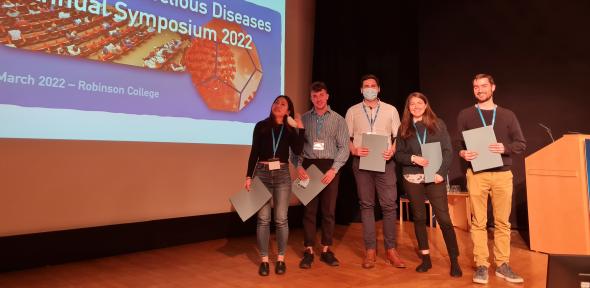
Submitted by Maria Bargues-Ribera on Wed, 20/04/2022 - 15:05
Last November 2021, Cambridge Infectious Diseases hosted a Research Sandpit focused on Antimicrobial Resistance (AMR) topics. The event was directed to the early career researchers in the network to promote their exchange of ideas and discussion, establishing new connections with people from different departments across Cambridge. Additionally, CID could offer a pump-priming grant of 10k to the best research project idea coming up from the Sandpit, thanks to an Isaac Newton Trust small grant scheme.
After the event, some participants gathered to write down short-term projects according to the budget, and CID Steering Committee members evaluated the proposals. Finally, CID awarded the Smart Probiotics team. The reviewers acknowledged a very interesting concept, a clearly articulated work plan, and great interdisciplinary within the team.
The Smart Probiotics team is formed by Daniel Buhl (Dept Veterinary Medicine), Santiago Caño-Muñiz (Dept Medicine), Felicity Crawshay-Williams (Dept Medicine), Pei-Yu Hsieh (Dept Pharmacology), and Tomas Kappes-Reveco (Dept Biochemistry).
We have asked them a few questions to inspire the following edition participants:
Antimicrobial resistance and the lack of antibiotic discovery are growing global concerns. Our smart probiotic project aims to produce a system that can deliver microorganisms engineered to release antimicrobial compounds upon detection of target pathogens. Through this system, we hope to achieve precise delivery and release of antibiotics to the site of bacterial infection, minimising off-target toxic side effects.
It all started at the Cambridge Infectious Disease Sandpit event where all of us shared an interest in antibiotic resistance. During the brainstorming session, we realised that a lot of drugs fail clinical trials due to their low efficacy or high toxicity. Moreover, many drug delivery systems tend to be overly complicated and unspecific. They literally end up everywhere! With some of our teammates already having experience in bioengineering of microbes, we wondered “Why not deliver a friendly bug and make it produce the antibiotic only when it detects the target pathogen?”.
Only two of us were working in the same lab at the time, everyone else met at the conference for the first time. What bound us together was the common interest in the field of antibiotic resistance and the shared belief that our project is extremely promising. Since we all agreed that the project exhibits potential, it was easy to arrange further meetings and discussions.
One of the things we appreciated most at the conference was the freedom given to come up with project ideas that could help reform the field of antimicrobial resistance. We were able to chat with several professors in the field of antimicrobial resistance in an informal setting, who helped guide our discussions and form practical project ideas, which was extremely valuable. For example, we initially proposed to work with an organ-on-a-chip model until they helped us break down the logistics of the cost involved. Moreover, during the writing of the research proposal, they helped us think about the necessary experimental controls and gave shape to the final project.
It was very nice to be recognised for our work after all the effort we put in. We are very excited about starting our first project together and learning even more in the process.
Yes, we would definitely recommend more people join the next Sandpit conference. It created a great opportunity for the different perspectives from researchers in the area of antimicrobial resistance to come together, generating a unique and interdisciplinary project outside of our own PhD projects. |

